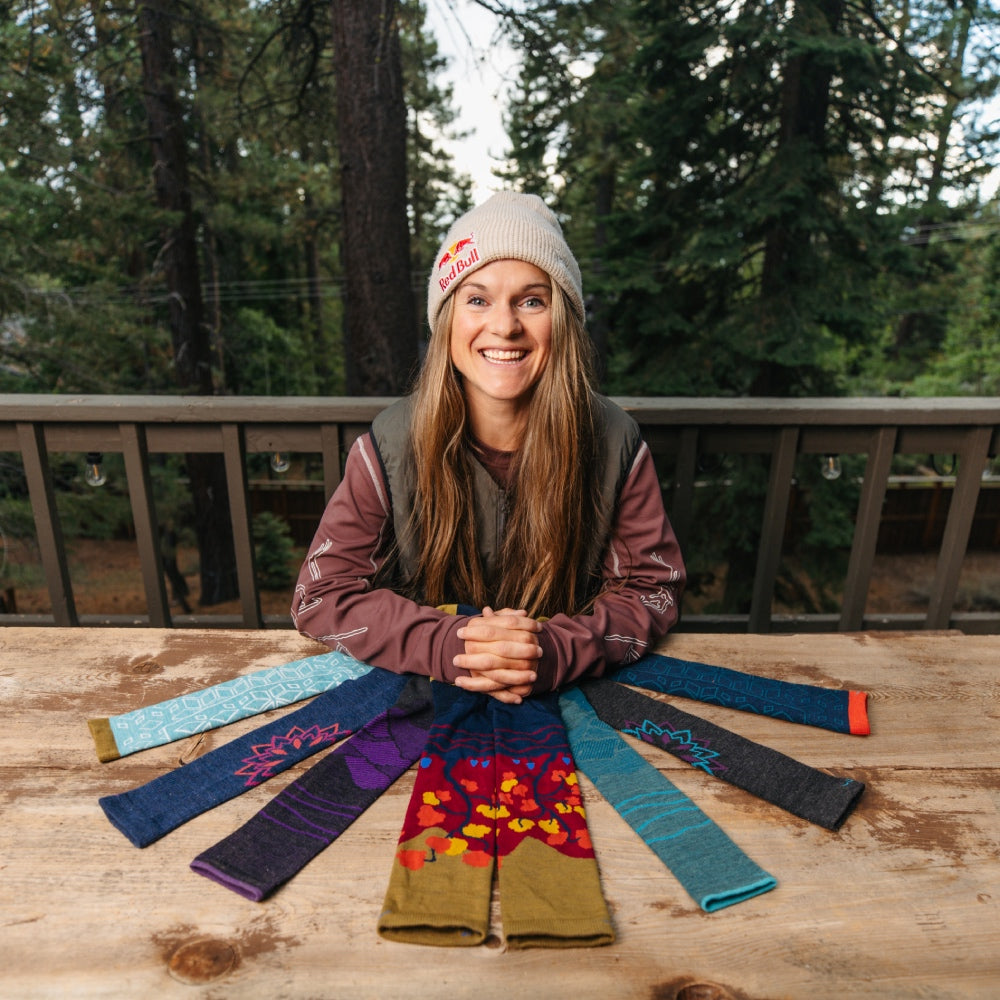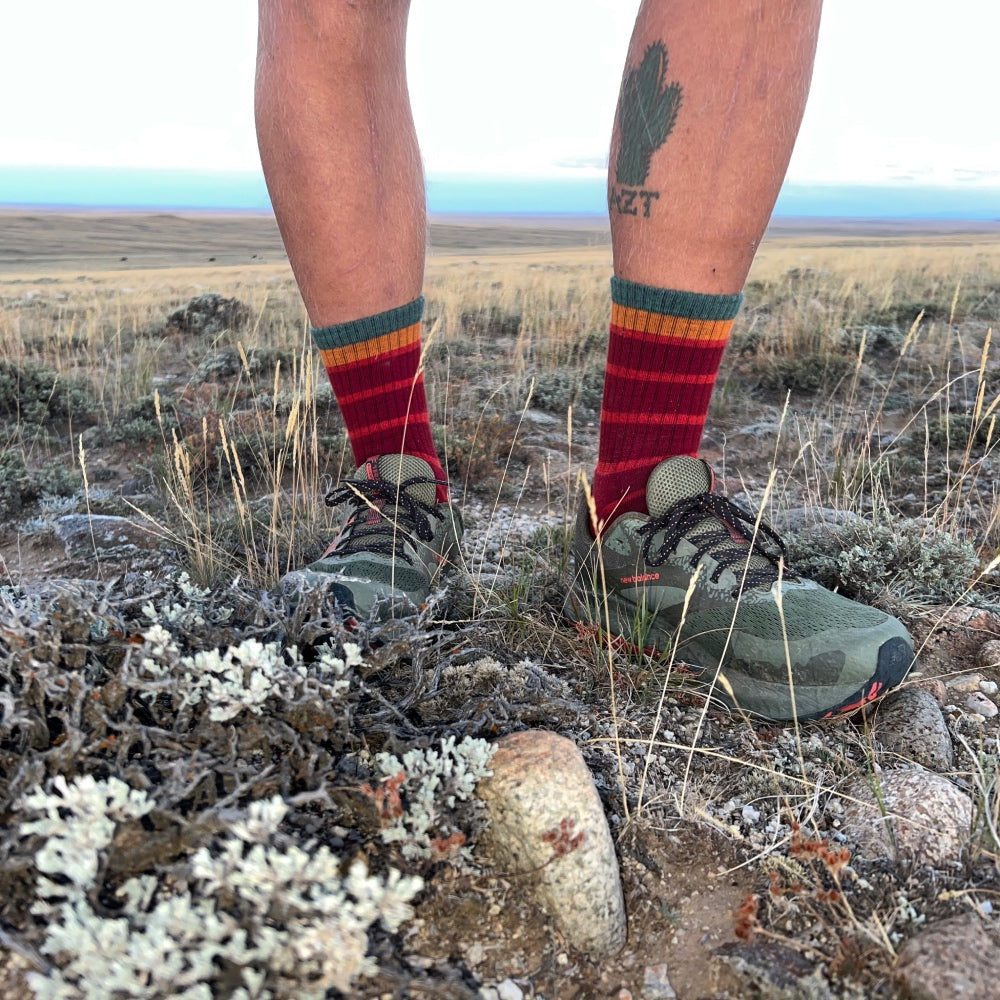Nature’s Most Amazing Fiber: Why It’s Only Natural We Love Merino Wool

If you have made it here on our blog, there’s a good chance you know that our socks are primarily made with 100% Merino Wool. But why?
Over the past 20-plus years, Merino Wool has become the choice material for the outdoor industry for many reasons. But what exactly is Merino Wool and why is it so special, and why is it different from the itchy wool that plagued us as children?
From high mountains to hot deserts, humans all over the world have been benefiting from the amazing properties of wool since 6,000 years before the common era (BCE), long before man-made fibers were invented. While wool is incredibly warm and excellent at repelling moisture and insulating, wool garments can also protect our bodies from the sun and help regulate our rising body temperature and keep it cool in extreme heat. Wool has the ability to protect our bodies from UV rays and is naturally fire-resistant.

The best part? All wool (including Merino) does all of this naturally. I’m one of Darn Tough’s fiber nerds, and today I’m walk you through the top reasons why we love Merino Wool and all that it does to our feet, focusing on what’s behind these amazing natural abilities.
Self-regulates Body Temperature
If you were to take a piece of wool fiber, slice it in half, and put it under a microscope, you would see an assortment of complex shapes that makes up the cortex, the internal cells that make up structure of the fiber.

The way that the internal cells of the fiber interact and react to moisture or heat is what gives wool its dynamic behavior. The two cells (the orthocortext and paracortex) are what trap the air and create an insulating effect (that warmth wool is known for). At the same time, scales on the outside of the fiber allow air to flow through the fiber, creating a cooling effect and allowing for breathability.
In the simplest form, when your body is hot, wool will work to keep it cool. When your body is cool, wool will work to keep you warm.
Moisture Wicking to Keep Feet Dry & Warm
What is truly unique about wool from any other fiber (natural or synthetic) is that it is a living organism. All other fibers that are harvested from a plant or manufactured in a lab will be processed to be a specific weight and for a specific purpose… and that is all they will be. They can be blended with other fibers to create additional benefits for the wearer or dipped in a coating to become water or heat-resistant, but they cannot adapt to the wearer’s body temperature or surrounding conditions.

Wool is different. Even after all the processes that wool goes through before it is knit into a sock, the fiber continues to fluctuate depending on the moisture it's exposed to and the conditions it's kept in.
Be it sweat, humidity in the air, the splash of a puddle, or some pesky snow that likes to wedge itself right into the rim of our boots, wool can absorb up to 30% of its weight in water and still feel dry to the touch.
Remember those scales on the outside of the fiber that allows for breathability? Those same scales also work to trap moisture as it's exposed to your socks, and unlike other fibers (natural or manmade), wool will continue to insulate even when it gets wet.
Odor Resistant
Humans are stinky. It’s a fact. Feet are notoriously sticky, especially when they spend all day in a hot shoe tromping around on trails or strapped into a foam-lined ski or snowboard boot.
Even if you are wearing your socks around the house on a lazy weekend, you might think you need to wash them after just one day. That is entirely up to you; however, I am here to tell you that you can prolong the life of your sock (and other wool garments) and save on water by simply taking your sweaty (or not-so-sweaty socks), turning them inside out, and leaving them out on your dresser, or hanging on your laundry rack overnight to air out.

Naturally porous, wool will let the air in the room pass through the garment, leaving it virtually odor free the next day.
If you are traveling or on the trails, and you only have a couple of pairs of socks and feel you need to wash your socks, you can give them a quick rinse with cold water in the sink (or stream), ring them out to remove all excess water, and hang them overnight (maybe into the next day depending on how warm it is), and you are good to go.
Compostable, Biodegradable, Renewable, & Regenerative
You might have seen some or all these words if you haven’t been living under a rock for the last 10 years. But in all seriousness, if you don’t know what those words mean, take a break, open a new tab, and Google them. These four words are very similar in their meaning and incredibly important when it comes to the future of our planet.
Compostable
You might know the word compostable as it pertains to where your food scraps go (instead of in the trash). Any organic matter that hasn’t been chemically added to or altered can be naturally composted and, once it is broken down, can be turned into nutrient-rich compost and used for fertilizer.
Biodegradable
All compostable materials are biodegradable, but not all biodegradable items are compostable. To biodegrade is to use one or more natural elements to help break down a product back to its most basic form. A biodegradable plastic bag will break down over time, but it will still be plastic. A compostable “plastic” bag is made up of natural plant starch and will compost back into that natural form and then be converted into compost.
What does this have to do with wool?

If you buried a 100% wool product in the backyard it will bio-degrade over time back into the natural proteins that wool is made up of. If that same product is buried in the compost pile, it will be thrown into the bustling world of billions of microorganisms and bacteria that will get to work breaking it down and absorbing all those proteins into its final product.
Renewable
Renewable, as it pertains to wool, simply means the sheep will keep growing wool year after year. In fact, due to the thousands of years of husbandry and sheep farming, most sheep rely on the farmer to shear them once a year so they can continue to live a healthy lifestyle. This continuous cycle ensures that if we continue to care for the sheep, the sheep will continue to care for us.
Regenerative
And finally, we come to regenerative. Regenerative is a holistic process, and it refers to the handling of the sheep more than the properties of the wool. Wool is a part of the regenerative process, but it is one of many steps that are required to be truly regenerative.
Sheep don’t need a lot to live. Give them a pasture of fresh grass (hay in the winter) and a source of water (and some minerals to balance their diet) and they will graze day after day.
The incredible part of this process happens under foot (or hoof). As the sheep graze, they also poop. That poop then gets pushed into the ground, creating the slightest disturbance in the soil that not only activates the grass to grow. but also fertilizes the ground along with organic matter (like bits of wool and fleece). This process, alongside responsible grazing patterns (which means giving pastures enough time to grow back before you re-graze it), draws carbon back into the soil out of the atmosphere.
Not only can the husbandry of the sheep play a massive part in helping our planet, but a 100% wool garment can be returned to the soil (either through composting or allowing it to bio-degrade) once it has lived a long life in your closet. That’s regenerative.

This is not how all sheep farmers farm, however. To that end, standards exist, including the Responsible Wool Standard (RWS). I plan to take a deep dive into the world of RWS and why it's important in an upcoming post.
What does this have to do with Darn Tough socks?
At this moment in time, we can only claim that we have a renewable fiber source, our Merino Wool. As we knit additional materials (nylon and spandex) into the construction of our socks, we do not have the ability to recycle or compost our product, so please don’t try and bury Darn Tough socks in your backyard or compost pile. While the 100% Merino Wool yarns in the socks might break down over time, there are plastics in the other materials that will also be released into your soil.
What I can tell you is that we are taking steps to make all the materials that we use as responsible and sustainable as we can.
Why Merino Wool
There are thousands of breeds of sheep that can produce wool with all the same natural benefits we just went over. So why is the outdoor industry going all in on this one type of wool, Merino?

Although all of nature is amazing, not all of nature’s fibers have equal performance capabilities when it comes to clothing. Merino has two qualities that make it unique from all other sheep wool: staple length (the length of each piece of fiber) and the thickness of the fiber.
The staple length of Merino is longer than other wools, and when it is spun into yarn, that long staple length has an easier time creating one consistent thread, which creates a smooth silky feeling against the skin.
Merino fiber itself is incredibly fine. We measure this in microns. The lower the micron, the finer the fiber. While not as fine as alpaca or cashmere (which comes from different animals), Merino is the finest sheep's wool in the marketplace.
Anyone born before 2000 will have some form of PTSD from their childhood from that itchy sweater they were forced into or that blanket that was just not cozy. What I can tell you now was that wool was not Merino. It was made from some other breed of sheep that has a shorter, thicker fiber. The ends of those fibers stick out even after being spun into one continuous piece of yarn, and it's those little ends of the staple that you were feeling scratching against your arms.
In other words, Merino Wool is one of nature’s finest inventions, the best wool to come off a sheep.

There is much more about wool that I could share with you, but for today I will sign off here.
If you feel inspired to learn more, I encourage you to visit Textile Exchange.
And keep an eye out – soon we’ll be diving deep into RWS wool and why it's important, and then looking into the other fibers we used in our socks and why.
Sincerely,
Darn Tough's Fiber Nerd
About the Author
Darn Tough’s Fiber Nerd loves sheep and wool so much that they live on a sheep farm. No joke. But while this fiber nerd might measure their life in microns, they do live by the belief that wool and sheep can make a huge impact in healing the planet. When not gushing about wool, this nerd is tirelessly working on new and exciting products for the Darn Tough family.







